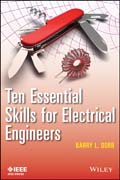
Engineers know that, as in any other discipline, getting a good job requires practical, up–to–date skills. An engineering degree provides a broad set of fundamentals. Ten Essential Skills applies those fundamentals to practical tasks required by employers. Written in a user–friendly, no–nonsense format, the book reviews practical skills using the latest tools and techniques, and features a companion website with interview practice problems and advanced material for readers wishing to pursue additional skills. With this book, aspiring and current engineers may approach job interviews confident in their grasp of the engineering skills that their employers seek. INDICE: Preface Acknowledgements About the Reviewers Note to Instructors Chapter 1 How to Design Resistive Circuits 1.1 Design of a Resistive Thevenin Source 1.2 Design of a Coupling Circuit 1.3 Design of a Pi Attenuator Problems References Chapter 2 How to Prevent a Power Transistor from Overheating 2.1 Electrical Model for Heat Transfer 2.2 Using Manufacturer’s Data for Thermal Analysis 2.3 Forced–Air Cooling 2.4 Dynamic Response of a Thermal System Problems References Chapter 3 How to Analyze a Circuit 3.1 Frequency Response of a Transfer Function 3.2 Frequency Response and Impedance of Simple Circuits 3.3 Frequency Response for Ladder Networks 3.4 Generalized Technique for Determining Frequency Response Problems References Chapter 4 How to Use Statis tics to Ensure a Manufacturable Design 4.1 Independent Component Failures 4.2 Using the Gaussian Distribution 4.3 Setting a Manufacturing Test Limit 4.4 Procuring a Custom Component Problems References Chapter 5 How to Design a Feedback Control System 5.1 Intuitive Description of a Control System 5.2 Review of Control System Operation 5.3 Performance of Control Systems 5.4 First Order Control System Design 5.5 Second Order Control System Design 5.6 Circuit Realization of a Second–Order Control System 5.7 First–Order Discrete Control System Problems References Chapter 6 How to Work with Op–Amp Circuits 6.1 The Ideal Op–Amp 6.2 Practical Op–Amps 6.2.1 Effect of Input Offset Voltage 6.2.2 Noise Contribution from Op–Amp Circuits 6.2.3 Dynamic Characteristics of Op–Amp Circuits 6.2.4 Effect of Capacitive Loading 6.2.5 A Nagging Issue Problems References Chapter 7 How to Design Analog Filters 7.1 Passive vs. Active Filters 7.2 The Lowpass RC Filter 7.3 Filter Response Characteristics 7.4 Specification of Filter Type 7.5 Generalized Filter Design Procedure 7.6 Design of Active Lowpass Filters 7.7 Design of Passive RF Filters Problems References Chapter 8 How to Design Digital Filters 8.1 Review of Sampling 8.2 Using the Z–Transform to Determine the Transfer Function and Frequency Response of Digital Filters 8.3 FIR and IIR Digital Filters 8.3.1 FIR Filters 8.3.2 IIR Filters 8.3.3 Comparisons between FIR and IIR Filters 8.4 Design of Simple and Practical Digital Filters 8.4.1 Averaging Lowpass FIR Filter 8.4.2 Lowpass FIR/IIR Filter Problems References Chapter 9 How to Work with RF Signals 9.1 Energy Transfer 9.2 Signal Reflections 9.3 Effect of Signal Reflections on Digital Signals 9.4 Effect of Signal Reflections on Narrowband Signals 9.5 The Smith Chart 9.6 Using the Smith Chart to Display Impedance vs. Frequency 9.7 Final Comments Regarding the Smith Chart Problems References Chapter 10 Getting a Job – Keeping a Job – Enjoying Your Work 10.1 Getting a Job 10.1.1 Getting an Interview 10.1.2 Preparing for an Interview 10.1.3 The Interview 10.1.4 Selecting the Right Offer 10.2 Keeping a Job 10.2.1 The First Year 10.2.2 After the First Year 10.3 Enjoying Your Work Afterword Index
- ISBN: 978-1-118-52742-9
- Editorial: Wiley–Blackwell
- Encuadernacion: Rústica
- Páginas: 272
- Fecha Publicación: 28/02/2014
- Nº Volúmenes: 1
- Idioma: Inglés
- Inicio /
- /
